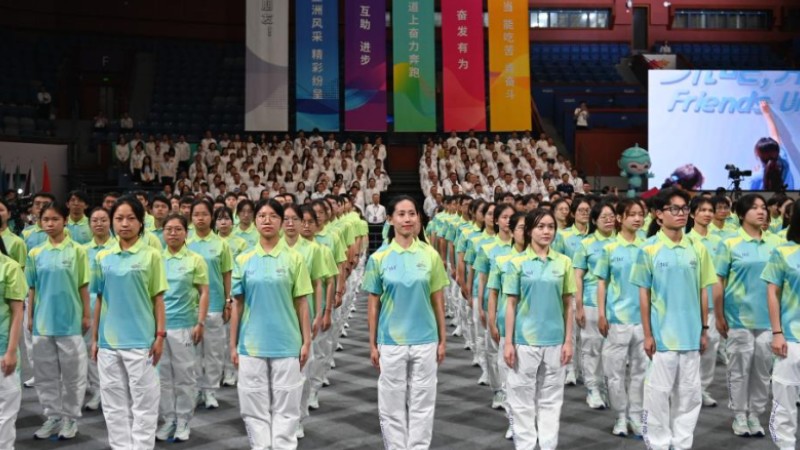How first set of kinetic pictograms for Asian Games is made
"The kinetic pictograms for the 19th Asian Games cover 40 major events and 61 sub-events, timed together in a 100-second video from start to finish. A lot of thought went into these 100 seconds," said Xuan Xuejun, deputy dean and professor at the School of Animation and Games, China Academy of Art. Xuan designed the pictograms for the upcoming event in Hangzhou, east China's Zhejiang Province.

Xuan Xuejun is interviewed by People's Daily Online. (People's Daily Online/Wang Liwei)
The kinetic pictograms, the first of their kind in Asian Games history, were officially released on Aug. 8, 2022. As a key part of the visual identity system for the 19th Asian Games, the pictograms bring the form and spirit of each sport to life through dynamic motions.
"Creating the kinetic pictograms involved an extensive process of research, analysis, discussion, and trial and error," Xuan explained. "We explored many different approaches, including 2D and 3D animation as well as Mixamo animation. Ultimately, we opted to use a game engine to generate the pictograms."

Photo shows the process of creating the kinetic pictograms for the 19th Asian Games in Hangzhou. (Photo courtesy of the interviewee)
Xuan explained that each sports pictogram contained intricate complexities - alternating lines, bending joints, changing endpoints, and more. Using traditional methods would have doubled the number of static frames and production workload required for the kinetic pictograms.
To ensure the pictograms' motions aligned with reality, Xuan's team extensively studied reference materials and competition footage, consulted sporting experts, and identified the essence of each event. They also utilized depth cameras to capture the movements from various angles.

It is the first time that Xuan Xuejun and his team use a game engine to generate kinetic pictograms for the 19th Asian Games in Hangzhou. (Photo courtesy of the interviewee)
For the fencing pictograms, typically lasting 0.5 seconds, the team slowed the actions to create a slow-motion effect, helping viewers better grasp the movements of the human body in fencing.
"Using a game engine to create the kinetic pictograms was a great first-time attempt from professional and academic perspectives," Xuan stated. "It opens up thoughts on how emerging technologies can empower design and art. We hope this innovative approach makes these pictograms appeal to more people and conveys the smart spirit of the 19th Asian Games."

Xuan Xuejun and his team use depth cameras to capture sports motions from various angles. (Photo courtesy of the interviewee)
Photos
Related Stories
- Hangzhou strives to hold the first carbon-neutral Asian Games
- Hangzhou gears up for hosting Asian Games
- 30-day countdown to 19th Asian Games marked in Hangzhou with drone show
- Hangzhou ready for 19th Asian Games
- Press conference for 19th Asian Games held in Hangzhou
- Nearly 40,000 volunteers to serve Hangzhou Asian Games
Copyright © 2023 People's Daily Online. All Rights Reserved.









